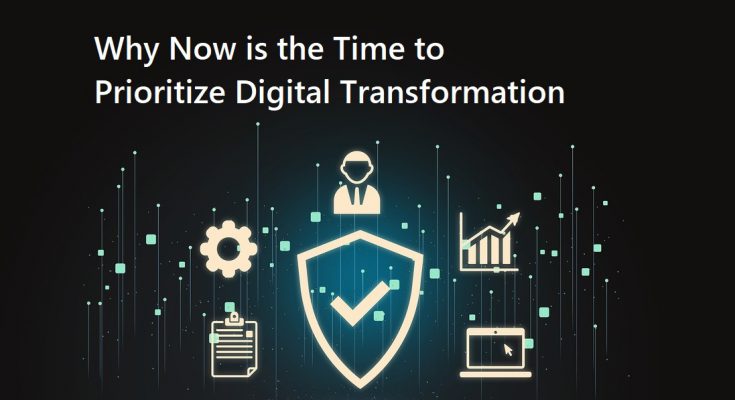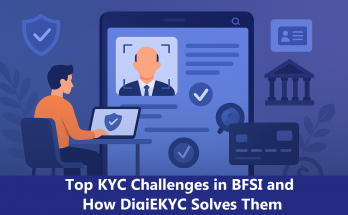By 2025, digital transformation is no longer aspirational, it is non-negotiable. Today’s digital momentum, fueled by rising expectations and regulatory demands, has made transformation less of a choice, and more of a critical foundation for business continuity. Now businesses must align their digital infrastructure with strategic foresight to stay competitive and relevant in a digital-first economy.
The numbers speak to the ongoing digital momentum. IDC forecasts global digital transformation investment to surpass $3.9 trillion by 2025, rising from $2.6 trillion in 2023. McKinsey also reports that digitally advanced firms can outperform their peers in revenue growth by 2.5x, while 85% of executives believe that failing to transform now carries the greatest risk.
With digital transformation now integral to business success, organizations must focus on defining and prioritizing initiatives that preserve their competitive edge and drive operational efficiency. Here, we provide key insights on why it’s now critical for businesses to prioritize digital shift.
Not interested in long reads?
Connect for a quick consultation on your digital roadmap.
Why Digital Transformation is Accelerating
Imagine your business value chain—from procurement to delivery—now imagine every link strengthened by data, automation, and intelligent systems. That’s not a vision of the future; it’s the new business baseline in 2025. The digital drive has become integral to creating value at every stage, across every touchpoint. Whether it’s enhancing visibility, improving agility, or enabling real-time responsiveness, digital capabilities are now central to enterprise performance.

Outlined below are seven defining factors pushing enterprises toward full-scale digital adoption:
The modern customer expects brands to not just serve, but anticipate and adapt to their needs in real-time. From one-click purchases to hyper-personalized recommendations, the digital-first mindset empowers businesses to deliver faster, simplify interactions and tailor every experience. Failing to meet these expectations risks losing relevance and loyalty in a landscape ruled by convenience.
2. Global Competition in a Digital-First Economy
Geographical boundaries no longer define competition. In 2025, companies face rivals from across continents, all competing for the same digital customer base. A robust digital presence allows businesses to scale operations, expand their footprint, and enter new markets with minimal friction. Embracing digitization means playing to win on a global field—24/7.
3. Cost Pressure and the Push for Efficiency
Economic volatility and rising input costs are forcing businesses to rethink traditional models. Digital solutions, be it automated workflows, cloud infrastructure or intelligent platforms, enable organisations to operate leaner and smarter. By minimising manual processes and reducing resource waste, businesses can maintain profitability while navigating complex market dynamics.
4. AI, Analytics & Smart Tech Adoption
Artificial intelligence and data analytics are no longer future tools, they are current-day imperatives. Businesses that digitize can leverage smart technologies for predictive decision-making, customer behaviour analysis, and operational foresight. With innovation cycles shrinking, the ability to pivot quickly and respond to market changes hinges on intelligent digital infrastructure.
5. Evolving Work Models and Workforce Expectations
Workplaces today are far more than just places to clock in and out, they are dynamic, digitally connected ecosystems. With hybrid and remote work now standard, organizations must invest in digital platforms that enable collaboration, productivity monitoring, and employee engagement across geographies. Moreover, tech-savvy talent increasingly prefers companies with modern, digital-first environments.
6. Cybersecurity, Compliance & Data Governance
With data becoming the lifeblood of businesses, cybersecurity and compliance are under intense scrutiny. Governments across the globe are tightening regulations, making secure data handling, access controls, and transparent reporting non-negotiable. Only through digitized systems can organizations implement real-time monitoring, encrypted communications, and audit-ready compliance protocols.
7. Omnichannel Presence & Customer Retention
In 2025, customers engage through apps, websites, voice assistants, and social platforms—all at once. A fragmented experience is a deal-breaker. Digitally mature businesses can deliver consistent, contextual, and connected experiences across all channels, enhancing customer satisfaction and driving loyalty. Omnichannel is no longer optional—it’s the backbone of retention.
Consequences of Delaying Digital Adoption
Delaying digital transformation is no longer a neutral stance, it compounds risk with every passing quarter. Outdated systems and manual processes limit the ability to innovate, drive up operational costs, hinder customer engagement and reduce the ability to respond to shifting market dynamics. As markets evolve and digital-native competitors raise the bar, the decision to stick with non-digitized task management and legacy workflow structures becomes a bigger drag on agility, efficiency, and trust.
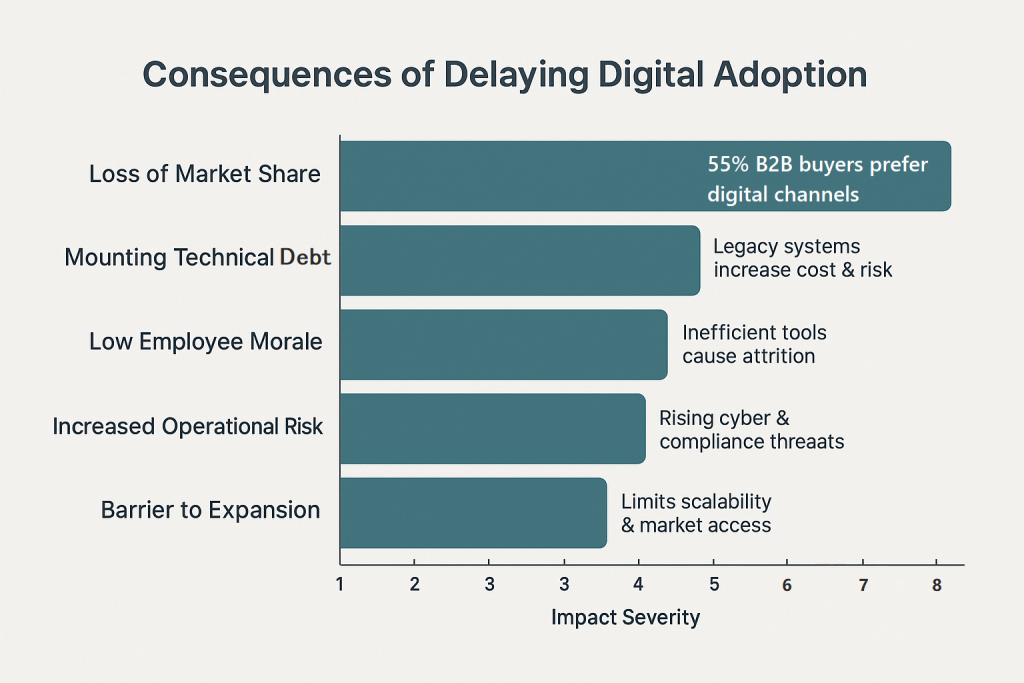
Delaying digital transformation often leads to a host of serious vulnerabilities—some of the most pressing are:
1. Loss of Market Share to Digital-Native Competitors
Digital-native companies are designed for agility and innovation. Their ability to leverage cutting-edge technologies and data analytics allows them to move faster, scale efficiently, and deliver personalized experiences. Delaying digital transformation makes it harder for traditional businesses to compete, often resulting in lost market share to more agile, digitally-savvy competitors.
2. Mounting Technical Debt from Patchwork Systems
Legacy systems and outdated infrastructure cannot keep pace with the demands of modern business. As businesses attempt to patch together disconnected technologies to maintain operations, technical debt builds up, complicating upgrades and integrations. This patchwork approach leads to inefficiencies, higher maintenance costs, and greater vulnerability to system failures, making future transformation efforts more costly and time-consuming.
3. Low Employee Morale Due to Outdated Tools and Inefficient Workflows
Employees working with outdated tools and inefficient workflows experience frustration and decreased productivity. A lack of modern, intuitive software creates bottlenecks, increases manual tasks, and contributes to a decline in morale. Over time, this dissatisfaction can lead to higher turnover, as employees seek workplaces that offer more innovative, streamlined solutions.
4. Increased Operational Risk in a Hyper-Volatile, Data-Driven World
In today’s volatile business space, operational risk is heightened by market conditions and customer expectations. Without robust digital systems, organizations struggle to collect, analyze, and act on real-time data. The inability to respond quickly to disruptions or opportunities exposes businesses to greater operational risk, leading to missed opportunities and costly mistakes.
5. Barrier to Expansion in Global and Digital-First Markets
As markets become more global and digital-first, businesses that resist digital transformation risk becoming irrelevant. Whether expanding into new geographic regions or offering digital-first products, companies must have the infrastructure to operate seamlessly across borders. Without the necessary digital capabilities, businesses face barriers to entry, limiting their growth potential in increasingly connected and tech-driven markets.
Today’s businesses operate in a digital ecosystem. Organizations that fail to adapt might risk losing their competitive edge, operational efficiency, and market relevance.
Why 2025 is the Benchmark Year for Digital Adoption
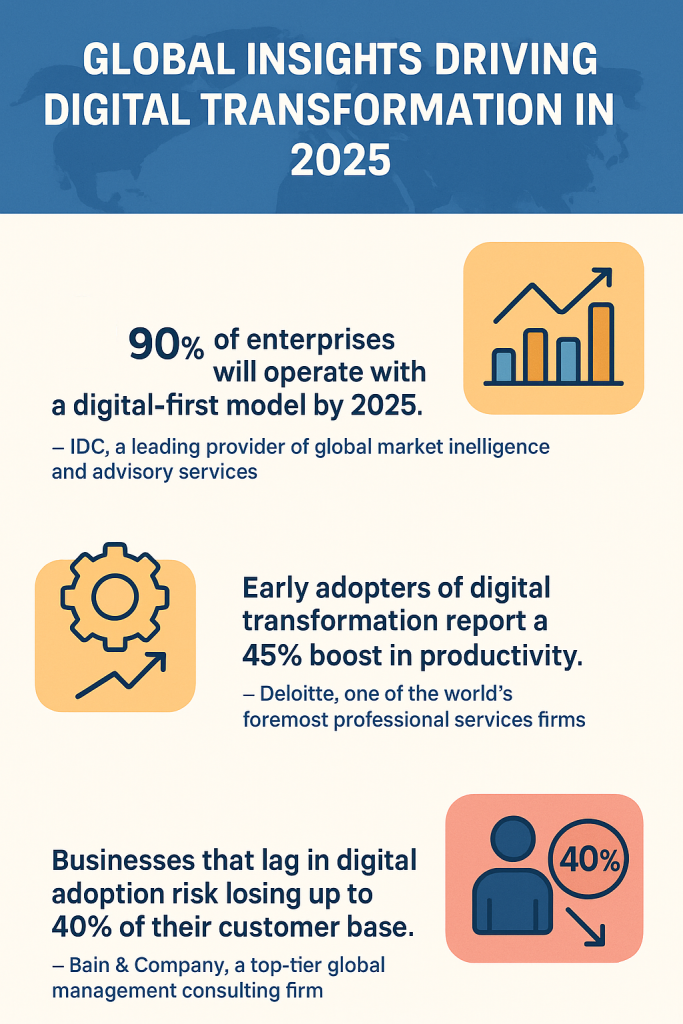
With 2025 on the horizon, there has never been a more strategic moment to pursue digital transformation. The rapid acceleration of digital adoption across industries validates why now is the best time to act—and why prioritizing the right initiatives is critical for success. According to IDC, 90% of enterprises will operate using a digital-first model by 2025, making traditional approaches increasingly obsolete.
Deloitte reports that organizations leading in digital transformation have achieved productivity gains of up to 45%, reflecting improved efficiency and responsiveness. In contrast, Bain & Company warns that businesses slow to adopt digital solutions may risk losing up to 40% of their customer base, as consumer expectations shift toward faster, smarter, and more personalized experiences.
To stay ahead, companies must prioritize scalable digital technologies, AI- and RPA-enabled automation, and customer-centric innovation. 2025 is not just a benchmark year, but a turning point for digital readiness.
Your Digital Transformation Roadmap with Tech Anand Rathi
Digital transformation isn’t a one-off upgrade, it’s a structured journey that evolves how a business operates, delivers value, and competes in the digital era. With increasing pressure to digitize operations, organizations require a defined transformation roadmap. Tech Anand Rathi provides an end-to-end framework to guide businesses from assessment to execution and help them build a resilient and scalable digital foundation.
Key milestones in the end-to-end digital transformation are detailed below:
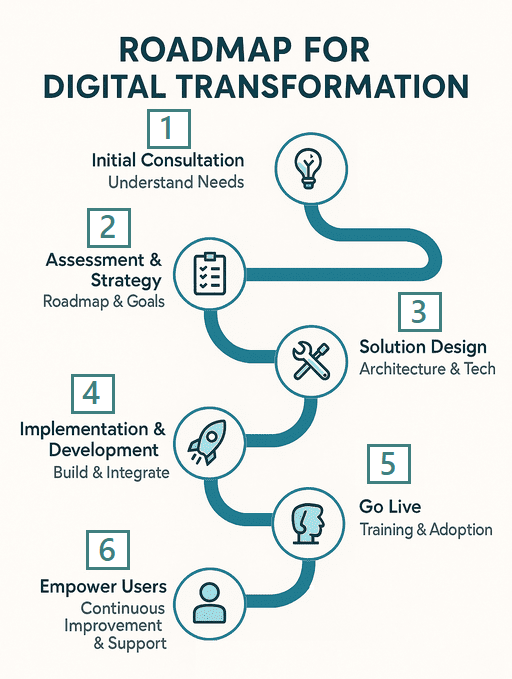
Step 1: Initial Consultation
The process starts with a focused discussion to understand the organization’s business model, operational bottlenecks, and transformation goals. This step allows both sides to align expectations, define success metrics, and establish the scope of engagement.
Step 2: Assessment & Strategy
A thorough assessment of current infrastructure, workflows, and digital maturity is conducted. Based on the findings, a tailored strategy is developed that outlines priorities, dependencies, risks, and a timeline-driven implementation roadmap.
Step 3: Solution Design
A solution architecture is created with specific technologies, integration points, and implementation models. This includes selecting platforms, outlining data flows, ensuring compatibility with existing systems, and planning for future scalability.
Step 4: Implementation & Development
The approved solution enters the development stage. Technical modules are built, tested, and integrated into the current environment. The focus remains on ensuring operational continuity, data integrity, and security compliance throughout the build.
Step 5: Go Live
After testing and validation, the solution is deployed. Training programs are conducted to equip users with the necessary skills to adopt the system. Change management and onboarding practices are applied to reduce resistance and ensure a smooth transition.
Step 6: Empower Users
Post-implementation support includes real-time monitoring, system optimization, and continuous improvement initiatives. Feedback loops are established to ensure the solution evolves with business needs and changing market conditions.
Empower Your Business with Proven Digital Solutions by Tech Anand Rathi
Effective digital transformation requires purposeful scaling. Partnering with the right team ensures your initiatives not only succeed but redefine your competitive landscape. With over 15 years of delivering digital solutions across industries, Tech Anand Rathi combines expert domain knowledge and technical excellence in hyperautomation, RPA, AI, cloud, web and mobile app development to create custom digital transformation solutions aligned with your vision.
Automate complex workflows, accelerate decision-making, and reduce operational overhead with scalable AI and RPA solutions.
Modernize legacy infrastructure and enable secure, scalable access to systems and data, anywhere, anytime.
Build agile, responsive, and user-focused digital platforms to engage customers and streamline internal processes.
Enable seamless data flow and process alignment through API integrations, ERP connectivity, and middleware architecture.
Unlock actionable insights through data engineering, business intelligence dashboards, and predictive analytics.
Transform concepts into digital assets through rapid prototyping and iterative development aligned with business goals.
Need Directions on Your Digital Roadmap?
Every business is at a different stage of digital maturity. Whether you are scaling operations, enhancing customer experience, or transforming internal processes, Tech Anand Rathi, as a digital transformation services provider, brings the precision, experience, and scalable technologies needed to deliver outcomes that matter in a digital-driven world.

